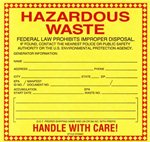Its violations include a failure to:
- Complete a hazardous waste determination for the waste it generates.
- Separate incompatible hazardous wastes.
- Provide adequate RCRA Training for its employees.
- Maintain a hazardous waste contingency plan.
- Properly manage and label its universal waste.
Usually I would harp on the failure to provide adequate RCRA Training since this sort of training is just what I do, actually it’s only part of what I do, but read on. However, I’m going to conjecture that violations of the EPA regulations will inevitably result in violations of the Department of Transportation (DOT) hazardous material transportation regulations and possibly cause a hazardous materials incident; here’s how.
I’ll assume that as a printer, the Rhode Island company uses flammable liquids as solvents, thinners, cleaners, in its inks, etc. It is quite possible that the hazardous waste determination failure was for materials such as these. If so, what should be an ignitable hazardous waste with the characteristic waste code of D001, might be identified as a non-hazardous material. This kind of mistake will then lead to the other hazardous waste violations noted in the press release. But what about when the hazardous waste is shipped off-site for disposal or treatment, what then?
I’ll assume that this company is a Large Quantity Generator (LQG) of hazardous waste and therefore must use a Uniform Hazardous Waste Manifest for its off-site shipments of hazardous waste. The use and proper completion of the manifest is a requirement of both the EPA and the DOT. Therefore, an incomplete or missing hazardous waste determination may result in the improper completion of the manifest. It may also result in the incorrect use of the remaining three hazard communication methods required by DOT for shipments of hazardous waste. Along with the manifest as a shipping paper, they are:
- Placards
- Labels
- Markings
Clearly, a violation of the EPA regulations to conduct a hazardous waste determination (40 CFR 262.11) can result in a violation of the DOT regulations when shipping hazardous waste. And not just a violation of the regulations. According to the DOT ~80% of hazardous material incidents in transportation are due to human error; another ~15% are due to package failure. Errors may result not only in violations and fines, but serious personal injury or damage to property.
The solution? One word: Training.
I provide the training that addresses all of these issues and more; conducted either as open enrollment training held nationwide and year-round or as on-site training tailored to your site specific needs. At my training you will learn the regulations of the EPA for facility personnel found at 40 CFR 265.16 and those of the DOT for HazMat Employees found at 49 CFR 172, Subpart H.


 (Boston, Mass. – Feb. 17, 2012) – A Rhode Island company that conducts printing, coating and finishing of specialty fabrics has been ordered by EPA to come into compliance with federal hazardous waste management regulations.
(Boston, Mass. – Feb. 17, 2012) – A Rhode Island company that conducts printing, coating and finishing of specialty fabrics has been ordered by EPA to come into compliance with federal hazardous waste management regulations.